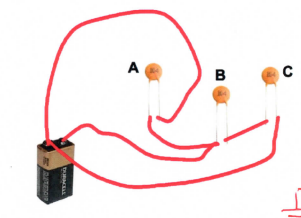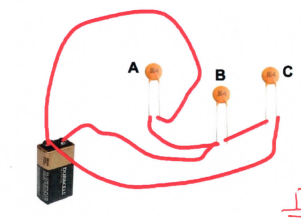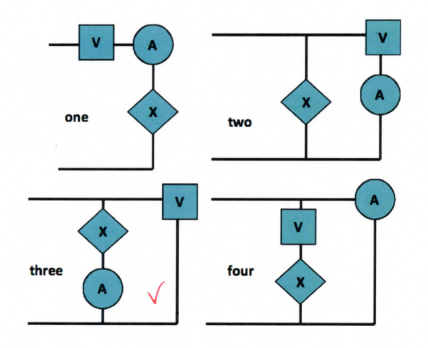Engineering Physics Multiple Choice Exam 2
1/47
Name | Mastery | Learn | Test | Matching | Spaced |
|---|
No study sessions yet.
48 Terms
Electric feild
is always perpendicular to equipotential surfaces
An electron volt is
the energy gained by an electron in moving through a potential difference of 1volt (1eV = 1e * 1V)
The fact that we can define electric potential energy means that
the electric force is conservative
A tiny sphere carrying a charge of 6.5 C sits ni an electric field, at a point where the electric potential is 240 V. What's the sphere's potential energy?
1.6×10^-3 J
The work, required to carry a particle with a charge of 6.0 C from a 5.0 V equipotential surface to a 6.0 V equipotential surface and back again to the 5.0 V surface is:
0 J
Which quantity or quantities take on the same value on all points of a good conductor?
voltage
Each plate of a capacitor stores a charge of magnitude 1 mC when a 100 V potential difference is applied. The capacitor is…
10 uF
fI the charge on a parallel-plate capacitor is doubled
the electric field is doubled
Dielectric filling in the capacitor
reduces the electric field ni the capacitor
Afuse is a piece of conductor designed to run up and break when the current through ti exceeds some rated value. To protect a circuit, ti should be wired
in series with the rest of the circuit
What is the resistance of the 100W light bulb when operating at V= 120 V?
144 Ohms, P = Vi = V(V/R) = R = V²/P = 144 Ohms
A compact fluorescent bulb produces the same light output as a 60 W conventional bulb, but it consumes ten times less power. How many of these bulbs can be put on a 120 V circuit protected by a 15A circuit breaker?
300, P = 6W, i = P/V = 6W/120V = 0.05 A, N = 15A/0.05A = 300
An ideal battery has an EMF of 12 V. fI ti is connected to a circuit and creates a current of 4.0 A, what is the power that battery produces?
48 W
The EMF of a battery is equal to its terminal potential difference…
only when there is no current in the battery
"The sum of the currents into a junction equals the sum of the currents out of the junction" is a consequence of
conservation of charge
The time constant RC has units of
seconds
Here si a loop equation: R(dq/dt) + q/C = Emf. What does this equation represent?
A charging cap
An electron has charge-e and mass me. A proton has chargee and mass 1840me. A "proton volt" equal to
1 eV
The fact that we can define electric potential energy means that:
The electric force is conserved
During a lightning discharge, a 30 C of charge move through a potential difference 1.0 × 10^9 J in 2.0 × 10^-2 s. The energy released by this lightning bolt is
3.0 × 10^9 J
A parallel-plate capacitor C has a charge Q. The actual charges on its plates are
Q, -Q
The capacitance of a single isolated spherical conductor with radius R is proportional to:
R, C = 4PiE0R
A car battery is rated at 80 A· h. An ampere-hour is a unit of:
charge, A = 1C/1s = A*s= C
In schematic diagrams, currents are indicated using arrows. What do the arrows indicate?
the direction that positive charge carriers would move
A wire with a length of 150 m and a radius of 0.15 mm carries a current with a uniform 72 current density of 2.8 × 107 A/m2 . The current is:
2.0 A, I = J*A = 2.8×10^7 A/m² pi(0.15×10^-3m)² = 1.98 A
Lightbulb A, a 60W model, and lightbulb B, a 40W model, are connected in parallel across a 120V power supply. Which statement below is false
Less current flows through lightbulb A than lightbulb B
The internal resistance in a real battery causes what to happen when the battery is connected to a resistive "load"? (Pick the best answer)
The voltage across the battery terminals decreases when the battery is connected to low resistance loads. The battery warms when connected to low resistance loads. The current supplied by the battery falls to less than the nominal battery voltage divided by the load resistance
The next four questions refer to the following figure below. The solid lines in the figure above represent high conductivity copper wire. The left capacitor has CL= 0.1 μF, the right capacitor has CR= 0.22 μF, and the battery establishes a voltage difference V = 9 V between its terminals. Which statement below is most correct?
(a) The two capacitors store the same charge
(b) The two capacitors have the same voltage between their leads
(c)The two capacitors have the same ratio of charge to voltage across their leads
(d) The two capacitors store the same energy
The two capacitors share the same charge
The next four questions refer to the following figure below. The solid lines in the figure above represent high conductivity copper wire. The left capacitor has CL= 0.1 μF, the right capacitor has CR= 0.22 μF, and the battery establishes a voltage difference V = 9 V between its terminals.
What is the absolute voltage difference between the left lead of the 0.1 μF capacitor CL and the right lead of the 0.22 μF capacitor CR?
9.0 V
The next four questions refer to the following figure below. The solid lines in the figure above represent high conductivity copper wire. The left capacitor has CL= 0.1 μF, the right capacitor has CR= 0.22 μF, and the battery establishes a voltage difference V = 9 V between its terminals.
How much charge do the two capacitors together store?
0.62 uC`
The next four questions refer to the following figure below. The solid lines in the figure above represent high conductivity copper wire. The left capacitor has CL= 0.1 μF, the right capacitor has CR= 0.22 μF, and the battery establishes a voltage difference V = 9 V between its terminals.
What is the absolute voltage difference between the two leads of the 0.1 μF capacitor CL?
6.2 V
Consisting of one of more pieces of conductor, separated in space, and used for charge and energy storage applications, this device is
a capacitor
Its essential elements are two different metals, spatially separated and sometimes immersed in an acidic solution. This is
a battery
To protect the circuit, how could you connect the fuse?
in series with the circuit in question
If 1000 J of work is required to carry 25 C charge from one point to another, the potential difference between these two points is
40 V
A 60 W light bulb carries a current of 0.5 A. The total charge passing through it in one hour is
1800 C
The figure shows a junction. What is true of the currents?
i1 = i0 - i2
for a cylindrical resistor that obeys Ohm’s Law the resistance does NOT depend on
the current
Pulling the plates of an isolated charged capacitor apart
increases the potential difference
“The sum of the EMF’s potential differences around a closed loop euqals zero” is a consequence of
conservation of energy
An ideal battery has an EMF of 12V. If it is connected to a circuit and creates a current of 4.0A, what is the power?
48 W

The next two questions refer to the following figure below. The solid lines in the figure above represent high conductivity copper wire. The three capacitors shown each have C = 01 uF and the battery establishes a voltage difference V = 9V between the terminals. What statement is most correct?
(a) A, B, and C are in series
(b) A, B, and C are in parallel
(c) A is in parallel with the series combination of B and C
(d) A is in series with the parallel combination of B and C
A is in parallel with the series combination of B and C

The next two questions refer to the following figure below. The solid lines in the figure above represent high conductivity copper wire. The three capacitors shown each have C = 01 uF and the battery establishes a voltage difference V = 9V between the terminals. Which relationship is most correct concerning the charges stored on the capacitors?
QB = QC > QA
In the context of the loop and junctions rules for electrical circuits, a junction is
where three or more wires are joined
A certain capactior, in series with a 720 Ohm resistor is being charged. At the end of 10 ms, its charge is half the final value. The capacitor is about
20 uF

The figure below shows four different ways that studio in previous years have wired up a voltmeter (square box with V) and an ammeter (circle with an A) to perform a simultaneous measurement of the current through and the voltage difference across circuit element X (diamond with an X). Assume “ideal” performance for the voltmeter and ammeter. Which is the only scheme that correctly measures the voltage across X and the current through X?
three

The figure below shows four different ways that studio in previous years have wired up a voltmeter (square box with V) and an ammeter (circle with an A) to perform a simultaneous measurement of the current through and the voltage difference across circuit element X (diamond with an X). Assume “ideal” performance for the voltmeter and ammeter.
Which scheme is most likely to blow a fuse in the ammeter?
four